Report on the 6th Global Symposium on Gender in Aquaculture and Fisheries (GAF6)
Bangkok, Thailand 3-7 August 2016
GAF6 – Engendering Security in Fisheries and Aquaculture – focused on multiple facets in fish value chains and society that matter in realising the security of women, in particular, but also men and communities. These facets include food security and nutrition, legal rights, access to resources and industry opportunities, fair livelihoods, dignified work, safety within the household, and resilience in the face of natural and climate change related disasters. GAF6 built on the overarching theme of food security of the 11th Asian Fisheries and Aquaculture Forum (11AFAF), the host of GAF6, and linked to the theme of the Conference on Climate Change Adaptation for Fisheries & Aquaculture (FishAdapt) (8-10 August 2016, Bangkok).
GAF6 learned that, while women have become more visible in fisheries policies such as the Small-Scale Fisheries Guidelines, in other policy arenas, such as climate change adaptation and fish trade certification, more needs to be done gender equality. Much needs to be done to remove structural barriers, and change social and fish sector norms that render women especially insecure in fisheries and aquaculture. Gender equality champions should be supported and women encouraged to speak up and act on their own behalf. Clichéd explanations for gender differences should be rejected as excuses for restricting people to lesser work, e.g., women should work near their homes so that they can also look after their families, and that women are better at menial post-harvest processing because they have more nimble fingers.
GAF6 began with a lively half day Training Workshop – GAF-101: Theorizing Gender in Aquaculture and Fisheries Research – in which more than 50 new and experienced gender researchers participated. Workshop leaders Marilyn Porter, Holly Hapke, Kyoko Kusakabe and Susana Siar set out to demystify theory. “Theory,” they said, “encourages us to ask, and keep asking, the question ‘WHY’?” The Training Workshop introduced how gender can be theorized in fisheries and aquaculture to provide frameworks for understanding cases, based on feminist research concepts of empowering everyone in society, and specifically creating more equal relations between women and men. Participants were urged to focus on gender relationships, not simply roles, and on intersectionality, as women’s and men’s lives were interconnected and gender interacted with other systems in society, e.g., cultural, political and economic structures. Groups presented and discussed the sample cases they had developed.
Participants were urged to focus on gender relationships, not simply roles, and on intersectionality, as women’s and men’s lives were interconnected and gender interacted with other systems in society, e.g., cultural, political and economic structures.
The present report on GAF6 responds to this injunction. We share the outputs under five lines of inquiry, each concerned with different aspects of realising security. The first asks whether current policies and practices are engendering security. The second questions why women are not better positioned in the burgeoning aquaculture sub-sector. In the third we explore the challenges for securing fair livelihoods in fish value chains. The fourth concerns climate change and the forces of change in coastal communities; and finally, we explore why realising security means transforming social and fish sector norms, especially gender norms.
M.C. NANDEESHA PRESENTATION AWARDS Best Presentation
Highly Commended
Best Student Presentations
11AFAF BEST STUDENT POSTER (GENDER)
Youth Art Awards
|
ARE CURRENT POLICIES AND PRACTICES ENGENDERING SECURITY?
The 2014 Voluntary Guidelines for Securing Sustainable Small-Scale Fisheries in the Context of Food Security and Poverty Eradication (SSF Guidelines) hold prospects for greater security for small-scale fishers and women in fish value chains. Debates at GAF6 concluded that as policy space for gender equality opens up, the opportunities nevertheless come with implementation challenges that require concerted action. In all cases, presenters observed that women were deterred from participating in decision-making. Women were invisible in most fisheries statistics and thus national policy makers did not include them and paid no heed to their interests, unless non-government organisations (NGO) and active women’s groups agitated to join the consultations. Even when policies and projects recognized women’s needs, however, governments and project managers often did not allocate money and expertise to back up their gender equality aspirations. Hopefully signalling a new trend, some recent projects were keeping their commitment to gender equality action.
The SSF Guidelines are opening up new policy space on gender equality. Yet, in implementing the Guidelines, women have been deterred from taking part in decision-making, are invisible in most fisheries statistics and their interests excluded from national policies – unless NGOs and women’s groups have advocated for inclusion. Even when women’s needs are recognized, money and expertise may not have been allocated. In a hopeful sign, some recent projects are committed to gender equality.
Xiangjun Yao, FAO Regional Strategic Programme Coordinator, welcomed GAF6 participants and highlighted the new normative instruments in fisheries and rural development that provide guidance on gender equality, especially the SSF Guidelines. The GAF6 Special Session on implementing the gender elements of the Guidelines had two objectives: to examine the SSF Guidelines through a feminist lens; and to use case studies to identify the main barriers, challenges and the best approaches for achieving gender equity and equality.
Since the 2014 SSF Guidelines included gender, Katia Frangoudes stressed that the next critical step is implementing the gender equality provisions. Examples from different regions are important because they reveal information on critical implementation barriers, opportunities, challenges to gender equality, including norms and values that may prevent gender equality. The ensuing presentations provided such information from different geographical areas.
In all the cases presented, women faced difficulty participating in the fisheries decision-making processes. In Japan, Kumi Soejima reported that women have their own sections within Fisheries Cooperative Associations (FCAs). The FCAs deal with all social matters related to the community and the fishery sector but women are not allowed to become full members of the sections that are empowered to discuss fishery management and the future of the community, and that run the banking system. Fishermen claim that women cannot become members of the FCAs because “they are not participating in harvesting activities.” Logically speaking, one might expect women divers (ama) who harvest abalone and other high value shellfish would qualify for full membership of the FCAs. But this is not the case because their right of access to the fisheries is granted by their husbands as members of the FCAs. This status quo however is being challenged by fisherwomen who have benefited from national schemes to develop their business capacities by establishing private or collective units to process fish products, and who demand to be completely involved in the fisheries organizations. For the time being, fishermen have not fully opened the door, and only some women struggling against male power have been successful. Women generally need support from scientists, prefectural and national fisheries authorities to force their way into the FCAs.
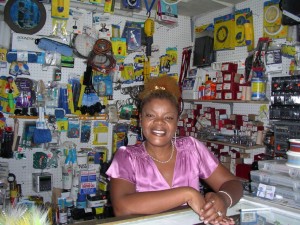
Woman fishing gear shop owner, Caribbean. Photo: Nadine Nembhard, GAF6.
Lack of statistics was identified as one of the reasons for the absence of gender-sensitive policies. In addition to statistics, Nadine Nembhard, from the Caribbean, identified the lack of gender mainstreaming in several Caribbean national fisheries and aquaculture policies, as well as the limited capacity of the national gender agencies to monitor, report on, and implement strategies in all sectors. Now, however, several regional agencies believe that implementing the SSF Guidelines will lead to women’s empowerment and capacity building. Nadine reported that within the Caribbean Network of Fisherfolk Organisations (CNFO), a “fisherwomen” section has been created and, together, CNFO, the Caribbean Regional Fisheries Mechanism (CRFM) and the Caribbean Community (CARICOM) aim to get a protocol on the SSF Guidelines, including gender, into fisheries policy. The regional and national efforts are being supported by the Gender in Fisheries Team (GIFT) hosted at the University of the West Indies Center for Resource Management and Environmental Studies (UWI-CERMES). GIFT research delves into the different roles and needs of rural and urban women and men in specific supply chains, such as the Barbados flying fish fishery, and in fisheries institutions where women are now more numerous than in the past.
Ravadee Prasertcharoensuk explained that, in Thailand, women are participating actively in small-scale fisheries, but national statistics are not sex-disaggregated and the needs of women are therefore not taken into account during policy formulation. NGOs that work for the recognition of small-scale fisheries communities and gender equality, promoting and supporting the active involvement of women fishers in national policy development and concrete local initiatives, view the SSF Guidelines as an important tool. They have used the Guidelines framework to conduct a national consultation forum in collaboration with the Department of Fisheries and representatives of provincial level small-scale fishing communities. A national implementation plan for securing sustainable small-scale fisheries has been drafted and is expected to direct the future actions of NGOs and civil society organizations.
Integrating women into decision-making also faces very fundamental policy challenges. In Kiribati, fisheries governance faced hurdles, according to Aurelie Delisle, when the country tried to implement a new mode of co-governance which called for equal participation by all user groups. Although paying particular attention to women’s involvement, participation had not materialized because cultural norms, traditional governance structures and the gender-blindness of fisheries authorities impeded the desired change.
Why does this failure occur? In spite of what is proclaimed in government gender policy, frequently gender equality strategies are not implemented. In 2003, the Government of Lao PDR promoted gender equity as a priority and established the National Commission for Advancement of Women (NCAW). Dongdavanh Sibounthong examined how national gender equity policy was being implemented locally in fisheries and aquaculture in Pakse and Phonthong districts, where district plans promote gender equality and the inclusion of women in decision-making. At the grassroots, however, Dongdavanh found traditional gender divisions of labour in fish value chains. Further, the district Agriculture and Forestry Offices had few women staff, few prospects of promotions for women, and no funds to advance gender plans. NCAW also lacked the funding and human resources capacity to provide assistance to sector ministries and district level offices. Another example comes from Vietnam where Roel Bosma found that sectoral Gender Action Plans (GAP) had not reduced gender inequality in aquaculture and fisheries. These plans did not address the constraints to gender equality, including the attitudes of men and families. Roel concluded that “the struggle for gender equality will be a continuous struggle.”
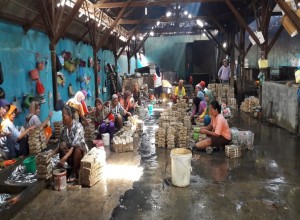
Traditional smoked and dried fish processing, Indonesia. Photo: Anindya Indira Putri presentation, GAF6.
Natasha Stacey and colleagues reviewed livelihood projects from the last two decades in Indonesia. The projects were supported by development assistance, and government and NGO resources. Most projects performed little gender analysis, did not follow through on planned gender activities and did not measure gendered impacts. As a result, no strategies yet exist to support women, who, as Anindya Indira Putri found, were suffering greater burdens in their triple roles (productive, reproductive and community), especially if men migrated to work elsewhere because resources and coastal environments had been degraded from exploitation, climate change and other factors.
Some new projects are taking gender equality more seriously than these past efforts. One is the USAID Oceans and Fisheries Partnership which, according to Arlene Satapornvanit, embeds gender policy and strategies in its work. For example, as part of its Asia-Pacific work to combat illegal, unreported, and unregulated (IUU) fishing and seafood fraud, the Partnership is strengthening the human well-being component by including gender tools and case studies in its Catch Documentation and Traceability system. The International Pole and Line Foundation, Peter Wessels reported, is also starting to work on the contributions of women in the tuna fishery supply chain in the Maldives, taking a complete value chain approach. The research, the first of its kind in the Maldives, is designed to feed into assessing how management measures may impact access to assets and the capabilities of women in the Maldives tuna fisheries.
Fisheries agencies are struggling to incorporate gender elements and provide support to women, but how is aquaculture, which is not specifically included in the SSF Guideline, coping? The next topic addresses aquaculture and gender in more depth but we conclude this topic on fisheries and aquaculture policy with Henk Peters’ (+ paper) evidence based on Oxfam’s GRAISEA (Gender Transformative and Responsible Agribusiness Investments in South East Asia) program. GRAISEA is piloting gender transformative approaches in shrimp value chains in Indonesia and Vietnam through the use of participatory social impact assessment. This tool is used in Aquaculture Stewardship Council (ASC) certification procedures. Oxfam felt that this participatory tool was underdeveloped with respect to gender and gender action learning was added to augment the tool. As almost all aquaculture policies lack gender equality provisions, an important part of the GRAISEA program is advocacy to influence sector wide sustainability initiatives with industry, certification bodies and NGOs. The work done by Oxfam in Indonesia and Vietnam provides initial recommendations for how to improve attention to gender equality: the participatory social impact assessment tool needs to be more gender specific and subsequent action planning should contain gender transformative activities.
WHY ARE WOMEN NOT BETTER POSITIONED IN AQUACULTURE?
Women’s progress in securing places in the fast growing aquaculture industry has received far less attention than has the positioning of women in fisheries. Often observers assume that women will naturally prosper in aquaculture because the modern industry is not burdened with the historical constrictions on gender roles found in fisheries. In fact, the evidence is that gender roles and relationships in aquaculture follow social patterns of ownership, rights and power typical of similar economic sectors. Unless they break out as entrepreneurs under their own volition or with help, women tend to be positioned in small-scale, near-home, and low technology aquaculture enterprises, or as low-paid labour in medium and industrial scale operations. However, small-scale household aquaculture can fulfil important subsistence roles and be tweaked, with expert help, to better satisfy multiple security needs, especially food security and nutrition. Women’s places are often accepted by society, including by many women, as suitable or normal and not explored further.
“Aquaculture is gendered,” said Surendran Rajaratnam, in introducing a preliminary report on a literature review of gender and aquaculture in the 7 focal countries of WorldFish programmes in Asia (Bangladesh, Cambodia and Myanmar) and Africa (Egypt, Nigeria, Zambia, and Tanzania). Of the 90 papers fulfilling the review selection criteria, almost half were on Bangladesh, while the number of papers on other countries ranged from 0 to 15. Patterns emerged out of the review: divisions of labour were gendered, with men dominating production while women tended to process and market the produce. Women were found to face challenges in accessing resources because of similar constraining factors such as household responsibilities. Studies integrating gender in aquaculture were limited while available papers tended to speak of gender as representing men and women and their roles and responsibilities. Only a few studies went further to discuss the underlying reasons for these gendered differences and/or use theories to explain their findings.
Aquaculture is gendered. Gender roles and relationships in aquaculture follow typical social patterns of ownership, rights and power. Unless they break out as entrepreneurs, women are positioned in small-scale, near-home, and low technology aquaculture, or as low-paid labour in medium and industrial scale operations. Nevertheless, small-scale household aquaculture can fulfill important subsistence roles and be improved to better satisfy food security and nutrition.
Several presentations confirmed that women tend to be found in small-scale aquaculture enterprises located close to where they live. Irna Sari reported on case studies in Indonesia, one on shrimp farming in extensive and intensive systems in Barru District, Sulawesi, and the other on homestead milkfish (Chanos chanos) processing in Sidoarjo District, East Java. The cases were meant to contribute knowledge and good practices to the FAO initiative Asia-Pacific Blue Growth Initiative. Homestead milkfish processing industries appeared to provide good opportunities for poor and unskilled women and full-time mothers but shrimp farming had low women’s participation, and most of this was concentrated in lowly or unpaid labour. The study found that both tangible and intangible benefits and outcomes needed to be carefully addressed, and care taken to incorporate the respondents own definitions of “success” and empowerment in aquaculture.
In many locations, aquaculture is being used as a new activity for improving women’s livelihoods. One of these, as Madhav Shrestha (+poster) reported, was on the Bhundrung and Thado khola flood plain river bed of Jhulyan village in Makawanpur district of Nepal, where researchers from the University of Nepal and NGO partners helped women, mainly from the Tamang ethnic community, to develop integrated farming systems and link to city markets. In Khulna, Satkhira and Bagerhat districts of southwest Bangladesh, Shahroz Mahean Haque (+poster) and colleagues found that 65% of women in aquaculture households played a role in the activity, with women in nearly half the households being very active. Women’s engagement did vary with type of aquaculture. Homestead aquaculture accounted for 30% of the women, commercial fish farming 23%, and only 12% were involved in shrimp culture.
Seaweed farming is a major aquatic farming endeavour and is often carried out by people living in remote coastal villages, including in Indonesia. Ria Fitriana (+poster) found that the farming of Kappaphycus alvarezii and Eucheuma spp in Nusa Tenggara Timur Province (10 villages spread out over Kupang, Roe Ndao and Alor districts) was comprised of family businesses in which women and men each had their own roles. In some islands of Rote district, however, women had their own farm sites, distinct from those of the men, in keeping with the more individualistic nature of the enterprises in these islands. Overall, however, women were generally more active in work close to their homes, a theme that recurs in many forms of women’s fish work. This pervasive theme has been examined in the literature on gender, economy and development. Research on gender in aquaculture and fisheries needs to draw on this literature more thoroughly to understand why it occurs and its many ramifications.
The majority (60%) of Indian ornamental fish come from capture from the wild. To promote the industry for export, the Marine Products Export Development Authority (MPEDA) created the Rainbow Revolution assistance scheme to provide subsidies and support group efforts at scales from small to large through ornamental fish aquaculture. Bharat Yadav’s studies in Maharashtra State incorporated gendered analyses into a study on the Rainbow Revolution beneficiaries, looking at the access and control of household, fishery and financial resources. For household, fisheries and financial resources, he found that women rated their access and control at near medium (50%), and never high; men’s ratings were high in all areas. Community norms, including the prevailing social hierarchy, demographic factors and special training on ornamental fisheries seemed to influence women’s positions.
Aquaculture, a form of farming, is often integrated into existing terrestrial farming systems. So how does it compare with other farming activities in terms of labour and time requirements? On small-scale farms (0.25-1.5 ha) in Soc Trang province, Vietnam, FAO compared women and men’s labour and their use of time in rice and rice-shrimp farming. Clara Park reported how the farmers in these diversified farms experienced seasonal differences in labour in which women tended to do more time-consuming tasks, and were more involved in rice production, whereas men were focused more on cash crops such as shrimp. Rice-shrimp farming was three times more time consuming than rice alone. During the shrimp season, women and men slept less and had less time for personal care. Due to these labour differences, shrimp farming was only marginally more profitable than rice and depended on the family labour. New technologies may have had different impacts on the labour of women and men, and often inventions were made by the gender most affected, e.g., the rice replanting tool was invented by a woman.
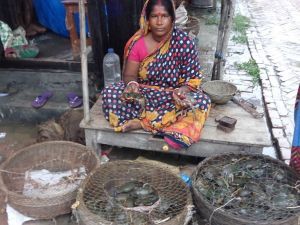
Khulna woman mud crab (Scylla serrata) farmer and her products. Photo: Shahroz Haque, GAF6.
Small-scale fish farming was often suggested as a solution for improving family nutrition. Three presentations, all supported by the AquaFish Innovation Lab, demonstrated that positive results are possible. In the first, in southwest Bangladesh, Shahroz Haque found that nearly 40% of mud crab (Scylla serrata) fattening operations were run by women. Despite the lucrative export markets for the mud crabs, however, the majority of the mud crab farmers were poorly educated, had poor diets, and many were malnourished. By including tilapia into the mud crab fattening and culture farming, households on the pilot farms experienced greater overall growth and production of mud crabs and their members were better nourished from eating the tilapia.
The second concerned successful women from Mishrit and Sundardeep cooperatives who had adopted polyculture of carp and small indigenous species (SIS) in Chitwan and Nawalparasi Districts of Nepal. To further improve the productivity of polyculture under reduced feeding, Sunila Rai (+poster) reported that 28 women and 7 men from Chitwan District were given a day’s training in how to enhance periphyton using locally available bamboo as the substrate. The experimental treatment produced more fish, including more SIS compared to the full feed baseline and more high-nutrient SIS were eaten by the families.
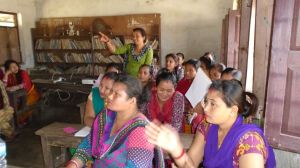
Women at training course on periphyton enhanced aquaculture, Nepal. Photo: Sunila Rai, GAF6.
A poster, the third presentation, by Jenna Borberg and colleagues explained the multi-faceted approach that AquaFish Innovation Lab developed and applied in closing the gender gap in aquaculture for improved nutrition. Four strategies were at the core of the approach. First, all AquaFish training activities had a 50% benchmark for women and men participants. Second, women scientists and administrators were given project leadership roles in research and mentoring. Third, program research focused on women’s roles, barriers to their participation, and their roles in household nutrition. Finally, gender inclusion was monitored and evaluated by collecting disaggregated gender data and performing gender analyses.
Consumer behaviour also has a role in nutrition. Milkfish or bangus (Chanos chanos) is the most important Philippine cultured fish, more so in Iloilo Province which is an important centre of production and which has nearly twice the national per capita consumption rate. Iloilo production is declining according to Reynold Tan, whose presentation explored consumer awareness and behaviours towards milkfish in relation to eight factors covering production and food quality. Women and men differed in their awareness of food safety of milkfish, and were similar in all other factors. However, on all factors, the differences in awareness did not translate into action in that men’s consumption patterns were strong regardless of awareness to various factors and men consumed more than women.
In the coastal zone, aquaculture interacts with existing uses, especially fishing, and its advent may clash or agree with prevailing ideas of best uses. Often women and men react differently. Jee Grace Suyo asked if gender mattered in a multi-agency project introducing sea ranching for sea cucumber in Pandaraonan, Guimaras, Philippines. Sandfish collection and trade were dominated by women but the project only examined social aspects after the biological stages of the project were underway. The social analysis revealed a plethora of important elements in which women and men responded differently, starting with where people gleaned, fished, farmed and made charcoal, through to income levels, membership of and trust in local organisations, and the types of incentives that attracted people to take part in the project. Women were more likely than men to respond to initiatives that informed and educated them, such as attending project meetings, but less willing than men to be hired as project labourers or to take responsibility. Men tended also to seek technical knowledge.
Benedict Carmelita examined women and men’s attitudes towards new government-promoted mariculture parks in Misamis Oriental, Misamis Occidental, Bohol, La Union and Pangasinan Provinces, Philippines. In most, but not all areas, proportionally more men than women liked having mariculture operations nearby but non-fishing households tended to be more favourably disposed towards having mariculture operations nearby than did fishing households. After mariculture was established, fishing, gleaning and leisure activities, including swimming and strolling decreased. Local employment was perceived to have improved with the introduction of mariculture.
Women are often spoken of as potential aquaculture entrepreneurs. The possibilities can sometimes surprise, given the traditional image of women as minor participants or participants in small-scale enterprises.
The good news story of Thailand’s Siamese fighting fish industry was presented by Amonrat Sermwatanakul who had experienced it first-hand and been instrumental in creating it. After 30 years of traditional extension experience in Thailand, Amonrat discovered the power of branding and social media to help the second generation of growers of these ornamental and sporting fish lift their trade to a new level. Many growers are women: for example, in Nakhon Pathom Province near Bangkok half the growers are women. Using Facebook and group training, Amonrat helped connect producers with each other and thousands of buyers, and provided training to women farmer groups in branding, product photography, as well as in online marketing to local and global aquarium fish markets through such sites as AquaBid.
In another breakthrough, Imelda-Joseph reported how, in Ernakulam district of Kerala state, India, women were headed for equality in fish cage aquaculture. Although the area studied was close to a city, its previous level of economic development was low. Initially, when cage farming started as an R&D project in 2007, women were not on the scene. However, in 2015, a women fish seller had noted the men making the cages and she started to follow their procedures. Now, 6-7 women have joined in and the number of women seems to be increasing due to the demonstration effect of the pioneer women.
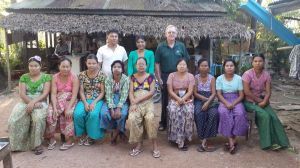
AIT experts Ram Bhujel and peter Edwards with Myanmar women in the agribusiness training project. Photo: Ram Bhujel, GAF6.
In a poor farming area of Yangon region, Myanmar, Asian Institute of Technology aquaculture experts, foreign donors and the Yangon government worked with groups of women in 11 villages to improve their integrated agribusiness operations. Ram Bhujel reported how the women became good detailed record-keepers in their thriving small-scale businesses such as prawn, pig and goat farming. More than two years after the formal project ended, the group efforts were still sustained. The groups helped to solve farm problems in a collective manner, such as how to treat animal health issues that could spread among their village enterprises.
SECURING FAIR LIVELIHOODS IN FISH VALUE CHAINS
Throughout, GAF6 participants emphasized that fisheries and aquaculture should be defined by reference to the whole of the value chain, and not simply to production, which is the current emphasis. Considering the entire value chain rather than just production reveals a greater number of women and a greater diversity of people who depend on fish, often in ways that were not envisaged by planners. Securing fair livelihoods raises a wide range of issues, especially: fundamental definitions of value chain occupations and the filters that may exclude or render many people, especially women, invisible; post-harvest matters that affect fair livelihoods; and the nexus of trade, labour and legality. Again, a persistent thread was that gender equality and equity must be fought for, and protected by active measures, rather than expecting it to happen through a sense of natural justice.
A persistent thread was that gender equality and equity must be fought for, and protected by active measures, rather than expecting it to happen through a sense of natural justice.
Individuals and groups may be deliberately or incidentally excluded when their informal and invisible work is not counted in national statistics and when fishing is too narrowly defined, for example, when practices such as gathering and gleaning are not considered to constitute “fishing.” Jennifer Gee of the Food and Agriculture Organization (FAO) reported how statistical exclusion, including that based on gender, was being addressed. FAO now reports the limited sex-disaggregated national data available and recently published new guidelines on census and sample survey methods for collecting socio-economic data. Efforts were underway to find ways to integrate project-based data, often the only data available, into national data.
In the production nodes of the value chain, narrow definitions of fishing exclude many small-scale operators. Susana Siar (+presentation) reported that inshore gathering, mainly of invertebrates, is most commonly excluded. In Costa Rica, both women and men fishers felt that though they work with dignity, their labour, primarily due to the particular conditions of the work and the associated lack of resources, went unrecognized, keeping them in poverty. Along the Pacific coast, 7,000 mollusc gatherers, mainly women and families working in the mangroves, had been trapped by laws that prohibited official recognition of their work unless the status of the fished stocks was known. This seemingly hopeless situation has started to turn around. One group began to organise themselves and managed to meet with the President of Costa Rica. With the help of the local NGO, CoopeSoliDar R.L, and the FAO, they started to work with the government to resolve the dilemma, using a human rights approach and participatory stock assessments, leading to sustainable use of the resource. Under the umbrella of the SSF Guidelines, this action is aimed at creating decent work with dignity, as defined by the SSF Guidelines.
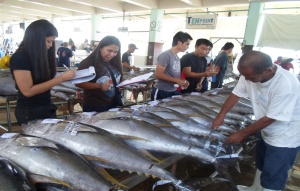
Women in the yellowfin tuna fish supply chain, General Santos City, Mindanao, Philippines. Photo: Ray Pavo, GAF6.
In another illustration of how the status quo may be challenged, Ray Pavo’s study showed how formal and official conceptions of gender and place in fish value chains that seem to be exclusionary may be circumvented. Using a framework that distinguished the overlapping concepts of lived, conceived, and perceived space, Ray studied why some women managed to work successfully in the major and overtly masculine tuna port in General Santos City, Philippines. He found that a small number of women prospered in their own business spaces, which they perceived quite differently from the way these spaces were conceived and managed by planners of the value chain, itself a conceived space. Some women’s spaces did not even intersect with the conceived value chain, such as the collection and use of fish entrails. The women did not perceive of their spaces as marginal, but rather as ones in which they had good livelihoods.
Also in the Philippines, in Davao Oriental, Jecelyn Pastor interviewed women who had been fishing offshore for many years, some of whom were involved in barter trade for fish products from the deep sea vessels, despite taboos about women bringing bad luck to deep sea fishing. She found that, due to such prejudices, women were invariably excluded when officials, researchers and other fishers considered deep-sea fishing policies, even though, through their own agency, they may have been active fishers and traders.
Horacio Gervásio asked why substantial subsistence fishing by women and men in Mozambique was not better integrated into local food systems. Under the new 2013 fisheries law, such fishing was defined as non-commercial and secondary, even though it contributed to the fishers’ incomes and supplied local hotels and elites. Intertidal fishing should be formalised, he contended, and women encouraged to apply the everyday business skills they used routinely to balance their portfolios of livelihood strategies.
Hilsha (Tenualosa ilisha) is considered the national fish of Bangladesh but women barely participate in the fishery and its massive supply chains. Safina Naznin is the gender specialist in the ECOFISHBD project that set out to give women more visibility and power in the hilsha fishery. She worked with women in all stages of the project cycle and was testing the hypothesis that greater women’s empowerment would lead to better hilsha conservation. Women within the project became more visible in the 80 fishing communities, made progress with their savings and alternative livelihood enterprises, and began promoting conservation by motivating their husband to comply with the regulations. Although the prevailing gender norms limited women’s mobility and freedom to act, their involvement in the incipient co-management system was important because men participated very little in the hilsa conservation initiatives.
Turning to factors in post-harvest value chain activities that could affect fair livelihoods, GAF6 presenters introduced gendered investigations into food waste in Zambia fisheries, a wide range of post-harvest processing cases from fish filleting in Mexico as well as many traditional and evolving Philippine value chains including some where women are gaining ground and others which employ disabled people for their special skills.
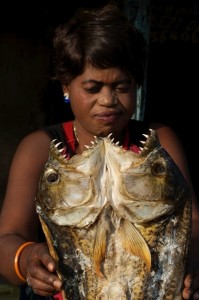
Woman fish processor, Zambia. Photo: Alexander Kaminski, GAF6.
In recent years, the theme of food loss and waste reduction had become prominent but, despite the gender divisions of work in fish supply chains, women or gender considerations have not featured in analysis and strategy. Alexander Kaminski examined the effects of gender on value chain losses in the Barotse Floodplain, Zambia and found that women experienced greater losses (biophysical, economic and nutrient) than men during fishing, processing and trading. As a result, the women’s gross margins were lower than those of men, except during trading. Using the Women’s Empowerment in Agriculture Index, the study highlighted the harmful norms and behaviour that probably led to the women’s greater losses, and used drama as a gender transformative communication tool to find ways of addressing these normative factors.
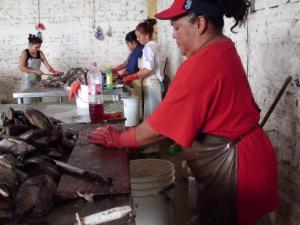
Women filleting tilapa, Lake Chapala, Mexico. Photo: Carmen Pedroza, GAF6.
Petatán is a fishing village on Lake Chapala, Mexico’s largest lake. The Lake is subject to climate change and pollution, affecting incomes from fishing and the quality of fish products. In numerous establishments in the village, women process the fish from the Lake and from nearby water bodies, turning the fish into a product that is marketable in major Mexican markets. Carmen Pedroza found that the women’s work provided them with income that partially satisfied their needs for secure and fair livelihoods. The filleting work stabilised their household incomes against the vagaries of fishing income from the lake, but did not supply them with social security and health benefits.
In the coastal provinces in the Philippines, the status of the fisheries resource often dictates the social and economic conditions and opportunities of communities. Recognizing this, the national Bureau of Fisheries and Aquatic Resources (BFAR) engaged the University of the Philippines in the Visayas to come up with a holistic livelihoods program – from “source to plate” – for gender-based post-harvest technology transfer. Emilia Yap reported on the rapid appraisal and training approach the University applied and tested in Carles, Iloilo. Men as well as women took part in the training for diversified and carefully chosen post-harvest enterprises. The project revealed that women and men’s work is becoming less strongly differentiated.
In the Balingasag Mariculture Park, in northern Mindanao (Region X), Philippines, milkfish (bangus, Chanos chanos) cage culture is a major activity, carried out in 28 small family, 24 medium and 11 large-scale enterprises. Alita Roxas reported how value chain mapping revealed that women do not work in the large-scale operations but tended instead to work in pre-stocking, and in processing plants and retailing. The value chain was oligopolistic: large wholesalers and retailers, some of whom also owned cages, captured most of the added value, followed by brokers and traders. Despite receiving government assistance, the small-scale cage operating families faced many barriers such as high unit costs of feed and fingerlings purchased at retail prices because the purchases were small. They often operated at only about a quarter of their capacity and families ended up mainly providing cheap labour to the main enterprises.
Many areas in the Philippines have their own unique resources, such as Oton and Tigbauan, Iloilo Province, Philippines, where the catching, processing and trading of the iconic sergestid shrimp (Acetes spp.) was segregated by gender according to typical patterns. Myra Iguban (+poster) described the women’s work as mainly involved in trading, although a few were engaged in the hard physical work of harvesting. Both women and men did the processing. As the small shrimp were harvested in large quantities, this involved large-scale operations for which men undertook most of the production. Women processors tended to work in groups to improve their profits, which were already greater than those of the male processors. Generally, women were becoming more important in the sergestid shrimp value chain.
The value chain for the blue swimming crab (Portunus pelagicus) in the Philippines is increasingly important as a source of employment and income. A study of people in different nodes of the value chain in 30 sites throughout the Philippines found that women were actively engaged in occupations from fishing preparation and operation to marketing and processing. Emilia Yap reported that, in some of the study sites, women were also involved in the top level management of crab processing plants and in managing crab fisheries resources. Women, however, were most prominent in marketing, processing and supply chain information. In one large processing plant, most of the factory floor workers were deaf and mute, hired for their careful work and heightened sense of smell in quality control.
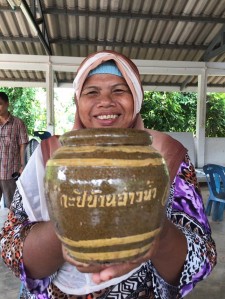
Shrimp paste manufacturer in a community processing group. The jar will be used for keeping the shrimp paste. The krill for making shrimp paste is from Phang Nga Bay, Kribi Province, Thailand. Photo: Supaporn Anuchiracheeva, the Small-scale Fishers and Organic Fisheries Products Project..
The nexus of fish trade, labour and legality occurs where fish trade is under pressure to minimise costs even at the expense of exploiting workers and operating outside the law. The labour conditions under which women in the fish sector work have received little public attention and have been barely visible in NGO exposures of other more publicly highlighted labour issues such as human trafficking and migrant labour exploitation. The GAF6 Special Session on the seafood industry, gender and social development encouraged participants to share experiences and perceptions of how women were affected. A broad-based panel discussed practices and experiences (or the lack thereof) linked with social responsibility and development in the seafood industry. Marie Christine Monfort, a seafood marketing consultant based in Europe and one of the panel convenors, noted the absence of women in the majority of high level decision-making positions in seafood companies, as well as in conferences and meetings. Thai business development worker, Supaporn Anuchiracheeva, shared her experiences on how participatory interventions empowered the women in a fishing community in southern Thailand to improve fishing practices, post-harvest, marketing, and business negotiations. The women’s status had been elevated and they were now supplying seafood with international certification to 5-Star hotels in Bangkok. Based on her experience in the International Labour Organization, Anna Olsen recommended that gender and intersectional analyses were essential in activities to create decent work in fishing and seafood processing.
Mohammad Nuruzzaman (+poster) described the factory provisions for occupational safety and health among female shrimp factory workers in Bangladesh. The push to do more on worker conditions was generated from two fronts. The first driver was the horrific collapse in 2013 of the Rana Plaza garment factory complex in Dhaka which brought recognition that shrimp factory and workers risk assessments were lacking but badly needed. The second driver was the pressure from international buyers and consumers who were worried about the shrimp workers. Bangladesh shrimp have become less competitive, having slipped to seventh position in exports from being second in 2009. Nuruzzaman stressed that the safety and health risk assessments are not the final point. Factory owners, managers and government agencies must remain committed to implementing the safety and health provisions, including training workers, recommended from the risk assessment.
This industry session and its panel stressed that concerted work with the seafood industry and development agencies is needed to raise awareness and build up capacity to achieve gender equality, as this is not yet on the agenda.
In the discussion, participants pointed out that, as women were prevalent in most fish value chains, their typical inequality could not be simply due to rarity. Gender is an economic, political and power issue, and inequality is a case of power asymmetries. The feminist perspective on gender issues in fisheries is needed now more than ever. Many participants felt that the political edge of working on gender has been lost. Many studies take the safe route of focusing on technical studies and tools. Furthermore, explanations for gender differences often resorted to cliché, such as “women’s hands are more nimble” in fish processing and other low-paying work, ignoring the counter examples, such as that most specialist surgeons were men. New political frameworks are needed to support women on the ground. Knowledge and skills are not enough, but rather changes are needed in behaviours. Will the Small-Scale Fisheries Guidelines be able to play a role and what more is needed?
The international media has reported on importing states and regional bodies such as the European Union cracking down on illegal fishing, but few stories carried the voices of those affected. Since 2015, Thai fishers, their households, communities and life options have been roiled by new trade threats from importing regions, especially the European Union’s “Yellow Card” on illegal, underreported and unregulated fishing, and the consequent national 2015 Thailand Royal Enactment on Fishing. Khamnuan Kheuntha examined why the fishers were experiencing seemingly constant and multiplying stress as new regulations placed more and complex demands on the fishers and their households. Khamnuan asked “was this stress due to more than the new regulations?” To answer this question, researchers needed to probe further. What was happening to male fishers’ identity, young people’s lack of interest in becoming fishers and learning from their elders, and the need to circumvent some new fishing regulations to survive? Additional burdens seemed to be placed on women to fish as well as process and sell fish, and gender relations may have shifted as the men’s concepts of their own masculinity were challenged.
Chalermwan Wichakoon, a young woman CEO of a Thai fishing company shared her perceptions on the current situation facing the fishing industry in the fight against IUU fishing. The voices of the fishing company owners were not heard and their opinions were not asked regarding media reports. This affected their businesses to the extent that the younger generation who inherited the businesses from their parents and grandparents, and especially women, were now thinking of giving up the fishing business.
Negatively and positively, fish trade and its growth impacts women. In coastal areas of India, Nikita Gopal described how women in fish marketing are being pushed out by resource rich traders who have entered the scene in many states. NGOs are helping the affected women to organise and raise awareness of their situation but, at the same time, state led interventions and schemes are also being initiated to explore livelihoods within and outside fisheries. The efficacy of these strategies was yet to be explored.
CLIMATE CHANGE AND THE FORCES OF CHANGE IN COASTAL COMMUNITIES
Communities along coasts, rivers and lakes are buffeted by many changes, including climate change. Planning based on, for example, climate adaptation vulnerability assessments, must be improved by including the gender metrics they currently lack. Coping mechanisms that allow people greater control over their lives may include migration, working with government, non-government and academic partners to take control, nurturing gender champions and bringing women to the decision-making table, and, after disasters, “building back better.” Agencies seeking to help communities need to take more nuanced views on what might work with appropriate needs assessment across all the players involved in the value chains, e.g., not supplying boats just to the men after a disaster, but also to women and focusing on the needs of women and men. Helping women does not mean working only with women in adaptation and recovery, as often the out-migration of men for work places additional burdens on women left behind.
Climate change is already affecting people in many environments, as reported at GAF6 and in the FAO FishAdapt: Global Conference on Climate Change Adaptation for Fisheries and Aquaculture. The GAF6 session on climate change and disaster preparedness, and previous GAF findings, were communicated at FishAdapt and built on by additional presentations and discussions in a Special Session.
Beginning in 2007, the Global Symposia on Gender in Aquaculture and Fisheries (GAF) began to focus on climate change, disaster recovery and relief as a theme, publishing a modest but important set of studies. The results of these studies showed that a gender lens brings deeper understanding of climate and disaster adaptation; that flexibility, versatility and agency are keys to resilience; and that gender-blind responses should always be challenged.
Using a gender lens brings deeper understanding of climate and disaster adaptation. Flexibility, versatility and agency are keys to people’s resilience. Gender-blind efforts to help people adapt should always be challenged.
Gender-blind approaches were a particular problem in climate change vulnerability assessments for fisheries. These assessments lack gender measures, as do climate change National Adaptation Plans (NAPs). Speakers at FishAdapt explained that vulnerability assessments are used to examine the vulnerability of people, human activities, and places, and to determine the ranking of countries and priorities for action. Methodological choices have a large impact on country rankings. GAF experts and climate change adaption experts need to work together to include the gender dimension as an integral part of the vulnerability assessments and of the NAPs.
Presentations and discussions stressed that climate change adaptation is deeply interconnected with many women’s issues: for example, when women are expected to engage in sex with fishers or fish traders to secure scarce fish for sale or processing; the spread of HIV; or the issue of rights and social protection for women and men along the value chain. Despite these linkages, the research on women in fisheries and aquaculture vis-à-vis climate change is very limited.
Marieta Bañez Sumagaysay described how women in Leyte, Philippines, asserted their agency through embracing the fish value chain in post-disaster livelihood intervention following the devastating 2013 Typhoon Haiyan. Women’s groups, once formed, were able to “build back better,” bringing all parties together, including donors. They created new, value added soft bone milkfish products with longer shell life and lower labour costs.
Following disasters, flexibility in income options for women and men seemed to improve household and community resilience. A study led by B. Shanthi and colleagues in Tamil Nadu, India, and presented by Angela Lentisco, found that, after losing their fishing livelihoods in the 2004 tsunami, many men migrated for work, leaving women to head the households. Researchers, NGOs and others successfully introduced brackish water aquaculture to the women to diversify their livelihoods. It was noted that in some aquaculture enterprises men seemed to facilitate and support women in their aquaculture activities.
Even without a disaster, migrations have become a fact of life and often disrupt fishing communities. Kyoko Kusakabe explored why migration is a pervasive feature of Cambodian coastal and inland fisheries. She found that migration patterns are not simple but were shaped by complex interactions of many factors, including gender, age, identity, resource depletion and alternative opportunities.
Flexibility and agency rely on perceptions, attitudes and emotions. At GAF6, Louis Lebel reported that the attitudes of Thai inland fish farmers towards climate risk were not strongly gendered, but their emotions were. Farmers’ decisions were not made just on analytical logic but emotions were also brought to bear.
From a study of perceptions of climate change by women and men engaged in reservoir fisheries in Karnataka State, India, at FishAdapt, Arpita Sharma (pp 39-44 in FishAdapt Proceedings) presented a gender analysis of the potential effects of climate change on livelihood of fishers. For women and men, composite livelihood vulnerability indices with exposure, sensitivity and adaptive capacity as parameters were computed. She reported that women and men experienced climate change vulnerability differently. Women had higher vulnerability scores and perceived that climate change would have more effect on most livelihood capitals (human, physical, natural, financial) than did men; both women and men perceived that their financial capital would be the most affected of all capitals. Thus the study suggested the need to integrate gender perspectives into mitigation and adaptation initiatives.

Bayas Women’s Association boat obtained after Typhoon Haiyan, Estancia, Visayas, Philippines. Photo: Mary Barby Badayos-Jover, GAF6.
Standard gender-blind responses to climate emergencies should always be challenged. Mary Barby Badayos-Jover interviewed women who told her that “every time people come here to give aid, they give boats! What about aid specifically for women?” Her presentation and those of others at GAF6 which covered events in the aftermath of Typhoon Haiyan in the Philippines, painted a more complex picture than most relief agencies might provide. Following Typhoon Haiyan, also known as Super-Typhoon Yolanda, which struck the Philippines in 2013, women in Bayas village, Visayas, formed a women’s association and were able to secure a boat to use in transport and also to rent out. Donations of boats to fishermen after a coastal disaster are often formulaic and not guided by needs analyses, but this action by the women is viewed as having greater legitimacy as it was based on their expressed needs. Hanny Mediodia’s studies showed that households lost proportionately more income from fisheries than from other household activities, providing some post hoc justification for the focus on donating boats.
In their poster, Morgan Chow and Hillary Egna reported on a follow-up study to an Asia-Pacific Economic Cooperation 2009 study on gender integration in disaster responses in the Philippines, using the cases of Typhoon Haiyan (Yolanda) 2013 and Typhoon Hagupit (Ruby) 2014. They examined municipal, provincial and national level views. Immediate concerns were focused on narrow gender issues such as the adequacy of evacuation centres and short-term livelihood options. More comprehensive areas for improvement were also identified, potentially leading to stronger gender and fish sector benefits, such as a shift in focus toward rehabilitation and future risk reduction.
Using the fish drying chain in Barangay Duljugan in Palompon, Leyte, Philippines as a case study, Marieta Bañez Sumagaysay explored the nexus between food, water and energy. Women fish dryers provided detailed data on water and energy needs and the pressures to provide the dried fish for food, income, gifts and export. As climate variability, already being experienced, increased, so too did demand for water from the well and the pump, demand for energy, and for food. Women fish driers needed to start developing a “nexus lens” for their businesses. Or, as the study concluded in verse: For every drop, a clean fish to dry. For every ray, a dried fish. For every dried fish, a plateful and a penny. For every plate and penny, more fish to dry…
The lively FishAdapt Special Session titled “Integrating Gender Considerations into Climate Change and Disaster Risk Reduction for Fishing Communities” stressed that the gender lens should be used at all stages of the National Adaptation Plans and climate change projects, from design, to implementation, and impact assessment. The “Too Big To Ignore” Special Session linked this to the need for gender training modules to enhance the ability of decision-makers to identify the specific needs of women. To move forward, gender champions must be identified, developed and capacitated. The fisher should also be brought to the table for others to hear her voice.
But climate change is not the only serious coastal change facing communities. What does a coastal city do when it wakes up to the parlous state of the resources and environment on which it has relied? Roxas City, Capiz Province in central Philippines found itself in this position in the early 2000s. It suffered from a litany of environmental problems due to fishing, illegal aquaculture structures, pollution and habitat destruction. Belinda Garrido pointed out that women bore much of the brunt in having to support their families in the face of such challenges. Consequently, 500 fishers, researchers, government and non-government workers came together to create and implement a comprehensive eco-tourism program that put people back into the ecosystem in more productive ways, starting with five chosen sites. Underpinned by diverse training courses from foot massage to vermiculture and resource interpretation for tour guides, women were half of the participants and managers. The ventures became a meeting points for schools, businesses, civic and religious organisations in efforts from clearing rubbish to replanting mangroves. Although parts of the sites were destroyed by Typhoon Yolanda in 2013, the community organisations proved their resilience and quickly rebuilt the assets. All enterprises have grown financially since the start in 2009, and women have proved to be the backbone. Community-based ecotourism became a strategy to sustain resource rehabilitation efforts.
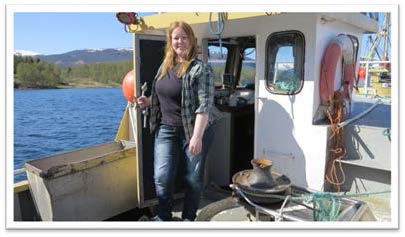
One of the rare registered women fishers in modern Norway. Photo: Siri Gerrard, GAF6.
Even in an equal opportunity country like Norway where fish production is an important economic sector, fisheries management changes have disrupted fishing communities in gendered ways. Siri Gerrard explained how, in 1990, women’s many fisheries contributions were not valued and thus were not considered in the privatisation of the fisheries. Women ended up owning little of the capital that was created by way of quotas, and although they continued to contribute, they did so in invisible ways and by bringing in household income from their work in other sectors.
Setting up protected areas to promote resource recovery also needs community adaptation. Liberty Espectato tested stakeholder values and beliefs in three Marine protected areas (MPAs) in the Municipality of San Joaquin, Panay Island, Philippines, in the Coral Triangle. Although female and male respondents valued the marine resources for food and livelihood and felt ownership of the MPA rules and regulations, a greater percentage of women believed in the need to manage the marine resources sustainably for the future generations. The MPAs succeeded in building the biomass of fish by one to five times and the positive community views on the MPAs supported high rates of compliance with the rules and regulations. Women had more complete formal knowledge of the MPAs than men because they had attended awareness-building activities. This could make women effective in social marketing of MPAs.
WHY REALISING SECURITY WILL MEAN TRANSFORMING SOCIAL AND FISH SECTOR NORMS
Social and fish sector norms present major constraints to secure rights and lives in fish value chains, often despite interventions to empower women. Several presentations pointed out why real progress in securing gender equality will not be achieved unless social norms are transformed. Preliminary results even suggest that women researchers in aquaculture may be experiencing greater difficulty in securing career progression because they may be at a disadvantage in publishing.
Real progress in securing gender equality will not be achieved unless social norms are transformed.
In Bangladesh, Afrina Choudhury examined whether women in homestead pond aquaculture and shrimp processing factories were empowered by their engagement in aquaculture. Both activities attracted many poor women, and they reported modest improvements in their empowerment, measured at multiple scales. The FAO-WorldFish study concluded, however, that we cannot assume that inclusion leads to empowerment, especially because household and factory attitudes and strictures on women constrained them to conform to their existing gender roles. She asked whether empowerment would be sustainable or even possible without normative change.
For Solomon Islands, Helen Teioli made a strong case that, to succeed, gender transformative processes needed to engage men as well as women. Ignoring men and regional differences in the transformative processes overlooked gender differences such as that Western Province women tended to lead changes and innovative activities more so than men, whilst Malaita men tended to innovate more than women.
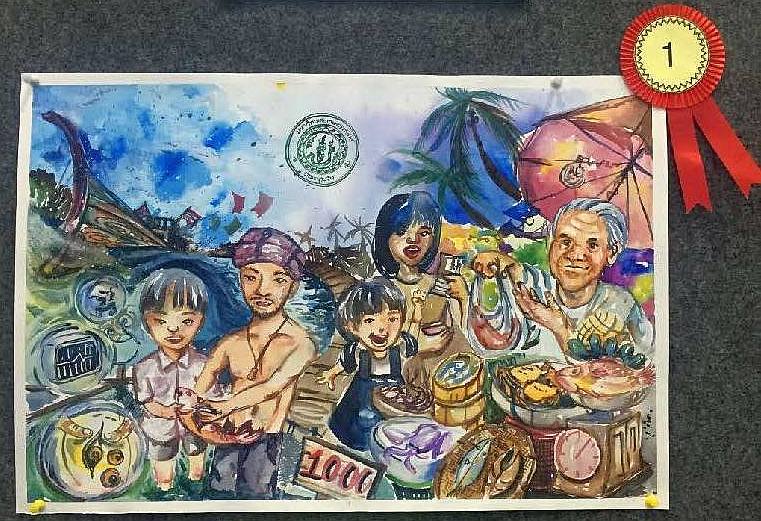
Senior High School Category, First Prize: Ms. Thummachat Thianpattanagul and Mr. Pichaiyut Puntasen, Surasakmontree School (Teacher: Ms. Tavarat Suthapoj). Photo: Conference organisers.
Long-term changes in perceptions will be helped if gender awareness starts early. In schools, art is one medium that might help. At GAF6, a “Youth and Fish” painting competition was held. In opening the event, Arlene Satapornvanit said “we should start our advocacy about gender awareness and sensitivity at a young age, so that these concepts will be incorporated into youth mindsets and be carried into adulthood as a lifestyle.” The Youth and Fish Session was a pilot activity involving students from senior and junior Bangkok high schools working in pairs. The art works revealed the students’ concern for the environment and people.
Mst. Kaniz Fatema provided an overview of women’s roles in the many components of the massive Bangladesh aquatic resource systems in closed and open water bodies, including aquaculture and fisheries. In a special wetlands case study on villages in Kawadighi and Hail Haor, Moulvibazar district in northeast Bangladesh, she found that men dominated the fishery sector. Women’s work on fish, in the household and in external engagement depends on permissions from men, even to the extent as to whether women could be interviewed for the study.
In 3 coastal barangays of Panay Island, Philippines, Feljean Cagape and colleagues studied the outcomes of the Pantawid Pamilyang Pilipino Program (4P’s) program, a human development effort by the Philippine Government that provided conditional cash grants to the very poor to improve their health, nutrition and the education of children. Women-headed households lacked access to physical assets such as land on which to grow crops and vegetables for the household. Marginalised women producers and providers of food needed to be promoted for household food security.
Vladimir Figueroa (+poster) reported he had just started a new project to study how gender and development communications could help improve women’s empowerment in women organizations in fisheries in the Philippines. Can women’s organisations, properly supported, challenge and transform the prevailing power dynamics?
Meryl Williams discussed a recent paper by Elisabeth Pruegl (“Neoliberalism with a feminist face: Crafting a new hegemony at the World Bank,” Feminist Economics, 2016) on the World Bank’s approaches to gender equality. Starting in 2001, empirical attempts to establish that economic growth and gender equality (and poverty reduction) were positively correlated produced mixed results: some studies supported the correlation, others contradicted it or gave ambivalent answers. The Bank then turned to micro-level studies, e.g., of institutions such as markets that had failed women. Should women be changed or markets and other social institutions be changed? The presentations at GAF6 reflected some of the possible answers to these questions. If women are considered unequal because of their different endowments, overcoming the gender gap with interventions to help women to compete can help, as illustrated by the participatory projects described by Supaporn Anuchiracheeva in the Earth Net Foundation, Thailand, and the Myanmar agribusiness skills training described by Ram Bhujel. Many presentations also addressed giving women greater voice, rights and negotiating power. Roel Bosma concluded that mass media communication needs to be used to enhance profound changes in norms, values and attitudes of men, before gender equality can be reached. Conversely, GAF6 participants often talked about markets and the economy as absolutes, e.g., lamenting but not challenging the low prices women receive in wages, and accepting the fish price as a financial fact, rather than as a constructed negotiable factor. Pruegl concluded that the World Bank’s emerging “modified kind of neoliberalism produces substantial openings” because it starts to address also the “coercively gendered institutions” previously treated as private, such as the family and care giving. In the new approach, the actors may become more embodied, less abstract. Susana Siar’s presentations on Costa Rica cockle harvesters and Amonrat Sermwatanakul’s social media marketing of Siamese fighting fish both revealed the embodied power of women’s agency. As fisheries and aquaculture are certainly about markets, and many at GAF6 stressed the need for a fish value chain approach, making markets for fish, for labor, enterprises, etc., work for women appear as worthwhile spaces for research and action in achieving gender equality.
A key element in gender equality is within the professional spheres of gender and fisheries. For researchers and other experts, academic publishing is a critical determinant of career progression, recognition and rewards. Hillary Egna reported preliminary results from a major study she and colleagues are undertaking on authorship in the academic aquaculture literature, focusing on rates by gender for total authorship, first, last and single paper authors. Author order was selected as a focus because authorship order is important for recruitment, promotions and funding. It is also determined by social processes, can be politically motivated, and is culturally embedded within the research and publishing system. From several large databases analysed, women comprised 15-16% of all aquaculture authors. First and last author positions were taken by women 13-15% of the time in aquaculture, lower than the overall science average of about 19%. Trends since 1982, when the AquaFish series of projects commenced, showed similar female and male changes, including the decline in recent years of single authored papers as research becomes an increasingly collaborative activity.
CONCLUSIONS
Women are gradually becoming more visible in some fisheries policies such as the SSF Guidelines, offering hope for more attention to gender equality in fish value chains. In other policy arenas, such as climate change adaptation vulnerability assessments and National Adaptation Plans, and fish certification systems, women are ignored. The SSF Guidelines have created space for national and international level action on securing greater gender equality. Much more needs to be done, however, to remove barriers that exclude women from the decision-making tables and to fulfil plans for inclusion. These actions could start with registering and counting women and their activities, planning and allocating funds for gender action and ensuring that expertise is available for implementing the plans. Gender champions should be nurtured and conditions fostered in which women can speak up and act on their own behalf. Perceived or culturally conditioned gender differences should not be accepted as reasons for excluding women or restricting them to lesser work.
In aquaculture, unless women make their way as entrepreneurs or receive help to develop their businesses and skills, they may be restricted to small-scale, near-home, and low technology enterprises, or as poorly paid labour in medium and industrial scale operations. Yet, when women are given or take initiative, their success can be remarkable. In coastal communities coping with change, even after disasters, success may come from “building back better” and taking a more nuanced view on which interventions might work, such as giving boats to women to help them in disaster recovery, rather than just to men. Conversely, often women will be helped when men also are helped rather than having men migrate for work, thus placing extra burdens on the women who remain.
The ultimate conclusion of GAF6, however, is that social and fish sector norms will have to be transformed to engender security, as they currently may stand in the way of gender equality and equity. Women will need new political organisation to galvanize the transformation.
GAF6 BACKGROUND INFORMATION
GAF6 gratefully acknowledges the support of the following agencies: Platinum Sponsor – AquaFish Innovation Lab; Gold Sponsors – Thailand Department of Fisheries, Asian Development Bank; Silver Sponsors – USAID, Network of Aquaculture Centres in Asia Pacific; Partners – Asian Fisheries Society, 11 Asian Fisheries and Aquaculture Forum, University of the Philippines Visayas, Asian Institute of Technology, SEAFDEC, Aquaculture without Frontiers, Marketing Seafood. We also gratefully acknowledge the technical support of the Food and Agriculture Organization of the United Nations, and support towards the fish Industry, Gender and Social Development Panel from the French Agency for Development (Agence Française de Développement). GAF6 was held as part of the 11th Asian Fisheries and Aquaculture Forum hosted by the AFS, Thailand Department of Fisheries and the Network of Aquaculture Centres in Asia-Pacific in Bangkok, Thailand, from 3 to 7 August 2016. FishAdapt: Global Conference on climate Change Adaptation for Fisheries and Aquaculture was held in Bangkok, Thailand from 8-10 August 2016.
GAF6 was the 8th women/gender in fisheries/aquaculture symposium in the series hosted by the Asian Fisheries Society (AFS, www.asianfisheriessociety.org) over the past 18 years. Founded in 1984, AFS is a non-profit scientific society that promotes networking and co-operation between scientists, technicians and all stakeholders involved in fisheries (including aquaculture) production, research and development in Asia. Its ultimate objective is to enhance food security and income-generating opportunities for fisheries workers via sound management practices, environmentally sustainable development and efficient utilisation of the aquatic resources.
GAF6 consisted of: the GAF-101 Training Workshop; 68 presentations – 47 oral presentations, 19 oral summaries of posters and 2 posters, organised in Special Sessions, some with panels, and Regular Sessions; 2 Special Sessions with panels; 3 Special Sessions, 5 themed Regular Sessions; a “Youth and Fish” painting competition for students; the GAF Networks Meeting, and an overview presentation at the closing Plenary of 11AFAF. See http://www.genderaquafish.com/celebrating-gaf6-announcing-prize-winners/ and http://www.genderaquafish.com/gaf6-program-abstracts-ppts/.
Website http://www.genderaquafish.com/ | Facebook http://www.facebook.com/pages/AFS-Gender-in-Aquaculture-and-Fisheries/181176555231544| Twitter @Genderaquafish | Flickr http://www.flickr.com/groups/genderaquafish/
[1] Parts of this report are taken and adapted from the articles published in Yemaya 52, “Gender inequality: GAF6 asks ‘WHY?’,” and “The climate for change.” http://www.icsf.net/en/yemaya/article/EN/52.html?limitstart=0
